
AI and the Retail Marketer’s Future
How AI transforms strategy and processes, driving the adoption of Positionless Marketing
Exclusive Forrester Report on AI in Marketing

So, you've managed to convert a customer. That's great, but what now? The data teaches us that 30% to 80% of customers in the e-commerce industry will only purchase once during their lifetime, and only around 60% in the gaming industry will place their second deposit. How can you gain long term customers with these numbers?
These questions keep marketers worldwide busy. They are working hard at the hidden art of pushing their one-timers, whether it's one-time purchasers (e-commerce, Online gaming) or one-time depositors (Gaming), into a second purchase. Why is the second purchase so important? The records show that when a customer makes their second purchase or deposit, the chances of making a third one increases dramatically, in comparison with the first to the second purchase.
In the table below, we gathered data from 10 leading e-commerce brands operating in Europe and the US to see the average chances of making another purchase. As can be seen from the chart, the chances of making another transaction increases as the number of the initial transactions increase. Another fact we can learn from the data? Since the chances of making a 2nd transaction is 41%, that means 59% of the customers are one-timers.
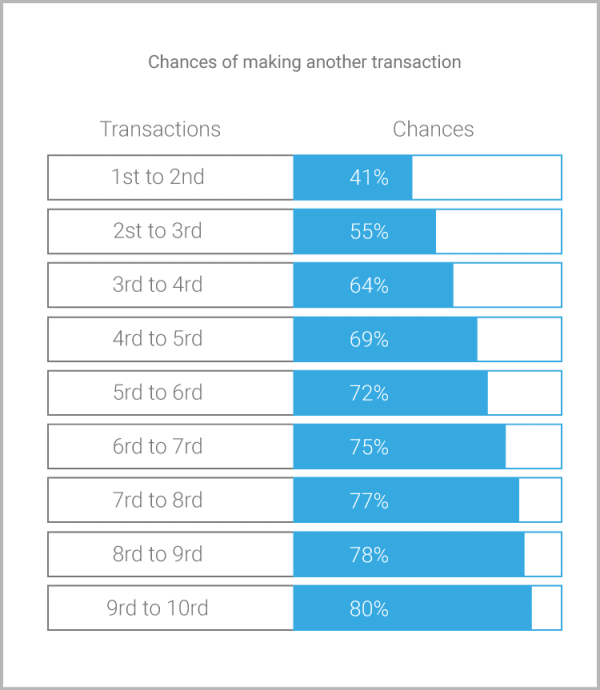
Many companies combine these one-timers into one group, and use different messages and offers to push them towards their second transaction. Sounds like a plan, doesn’t it? After all, the customers in this group are all one-timers. We are here to discuss a different approach. This second method breaks the 'one-timers' group into several segments with the data we’ve already gathered from that single transaction they made. Let’s drill down and understand the reasoning behind it:
We started with analyzing the behavior of multi-time purchasers of 10 leading e-commerce brands, and tried to understand whether there is a connection between the day when the first purchase was made and the day of the second purchase. We began by running the analysis on the sports gaming industry. In this industry, a customer places his deposit on the day when the most matches of his favorite league occur, usually Saturday or Sunday. The chances for this customer to return and place his second deposit on a Saturday or Sunday are pretty high.
We put our data to the test, and the results for the gaming industry were as expected. As you can see below, most of the multi-deposit bettors (who hadn't placed their second deposit during the first 7 days), make their second deposit on the same day of the week as the first one.
As we can see in the table above, most of the second deposits were held on the same day of the week as the first deposits, as you can see in the diagonal boxes in grey. For example - 19% of the customers who placed their first deposit on a Wednesday (and haven't placed their second deposit during the same week), placed their second deposit on a Wednesday as well.
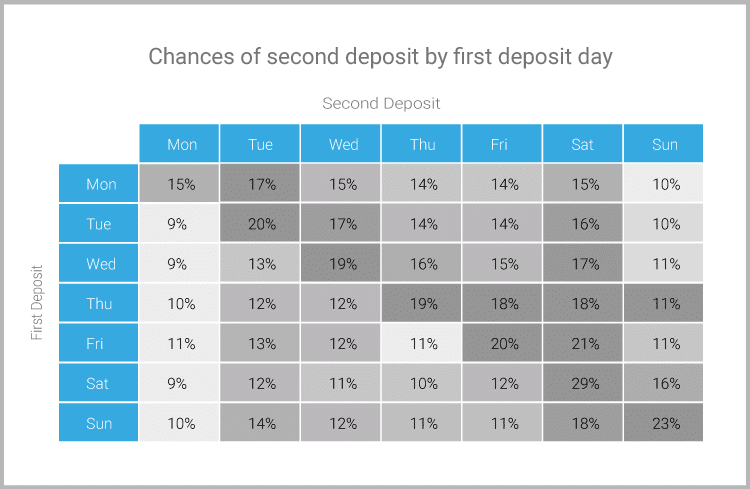
The correlation between these two transactions can help us better target different cohorts of one-timers, (in this case, there are 7 groups, based on the days of the first transaction) and push for the second transaction on the most relevant day.
The more interesting step was to test this assumption with the e-commerce industry. After running the analysis based on multi purchasers who made their second purchase at least one week after their first one, we got the following table:

We can see the same pattern occurred. Customers tend to make their second purchase on the same day of the week as their first.
It is highly important to mention that the variance was higher here than in gaming, but such patterns recurred in most companies. The table below explains an additional pattern that manifested itself from the data of one specific brand.
Here, there are 2 important days in terms of purchasing from this retailer. Monday is obviously the strongest day – no matter what the customers' first order day (day of week) was - while the weakest day for this retailer is Saturday. But although the pattern shows Monday as the strongest day of the week, we can still see the diagonal line for this customer clearly:
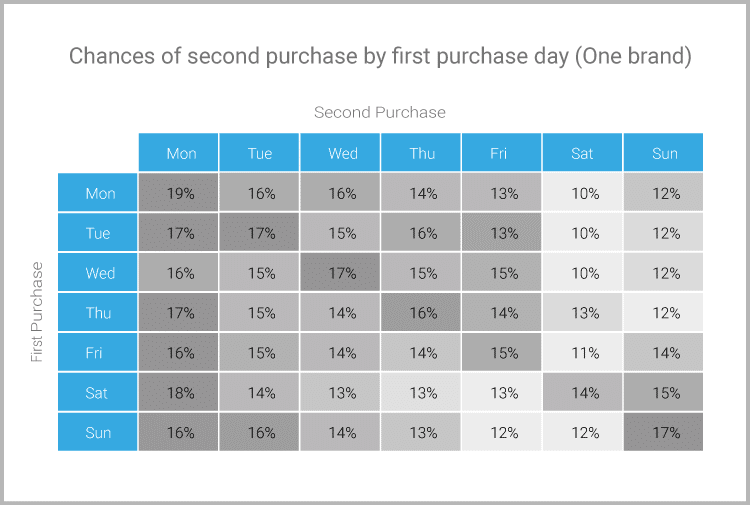
We have a good explanation for this pattern in the gaming industry, but why do we see this pattern in e-commerce as well? The reason could rely on the fact that e-commerce customers, like gaming customers and humans in general, have consistent patterns in life. You go to the gym on Tuesdays and Fridays, have fun with the family during the weekends, stay late at work on Monday and meet with friends on Sundays to watch the NFL. A shopping pattern shouldn’t be a strange concept after all.
As you already guessed, we've tested the same patterns for time of the day. Is there any correlation between the timing of the first purchase and the second purchase which occurred at least 7 days later? In the following analysis, we broke the days into 4 segments – night, morning, afternoon and evening, and checked the distribution of a second purchase for each first purchase time group among 6 different e-commerce brands. Here are the results:
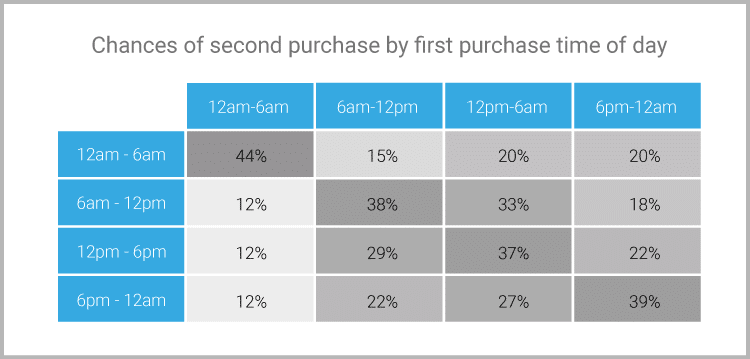
The correlation between the first and the second purchase in terms of timing suddenly looks obvious (again, the diagonal cross). Customers who purchased their first order late at night, will probably purchase their second one at the same time.
As marketers, we aim to push our customers to increase their transactions - "Purchased a dress for $50? why won't you try those matching shoes for $75 (only $75 of course)”. Up-selling in the marketing world is a way of living, and if not - it should be.
But should we always up-sell? Is up-selling the right solution and treatment for all our customers? In the analysis we conducted, we examined whether our customers tended to increase their purchases - especially when moving from one-timers into second-timers.
Due to the fact that we conducted the research on different brands from different markets, it is complex to determine the brackets by fixed prices (all customers who purchased between €10-€25 on the first purchase, for example). The brackets were determined by the first purchases distribution - defining a minimum and maximum price for each one of the 6 brackets. Here is the final average table:
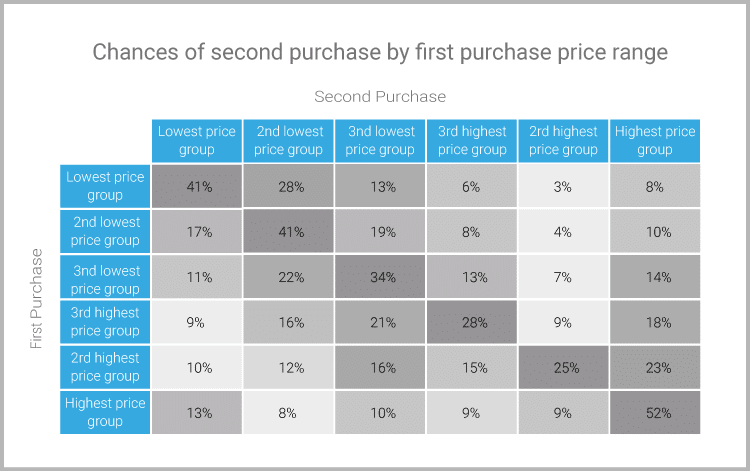
Most of the customers whose first purchases were mapped in the lowest price range, were also mapped in the same group on their second purchase (41%). It’s the same trend that runs through this entire piece - Most people have repetitive patterns, and customers tend to make their second order for the same price (more or less) of their first order.
We can see that the strongest correlation appears in the highest price group - 52% of customers are falling into this group in both of their transactions - it is important to mention that there is no upper limit for this group and our big spenders will probably stay our big spenders.
The analysis above exemplifies how we can learn from our customers' first purchase. The most important thing we need to remember is that our one-timers shouldn't all fall into one big segment. In case you aren't targeting your one-timers differently based on their favorite department/product and you have a recurring funnel for them – now is the time to start doing that. The second step, of equal importance, is to break the groups you have created based on the data you have from the first transaction, into more granular target groups. This will help you target your customers more cleverly. Here are few ideas:
The last and most important tip is to explore. Analyze your customers' first purchase, look for patterns and similar behavior. Try to learn from your multi-timers and to use your results as inspiration for your one-timers. Using these methods and steps will help you better understand how to increase the LTV of your one-timers and turn them into loyal customers.
Exclusive Forrester Report on AI in Marketing
In this proprietary Forrester report, learn how global marketers use AI and Positionless Marketing to streamline workflows and increase relevance.


Writers in the Optimove Team include marketing, R&D, product, data science, customer success, and technology experts who were instrumental in the creation of Positionless Marketing, a movement enabling marketers to do anything, and be everything.
Optimove’s leaders’ diverse expertise and real-world experience provide expert commentary and insight into proven and leading-edge marketing practices and trends.


